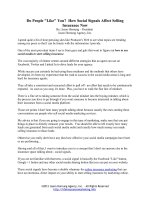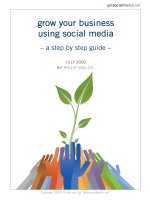Satellite marketing using social media to create engagement
Bạn đang xem bản rút gọn của tài liệu. Xem và tải ngay bản đầy đủ của tài liệu tại đây (16.02 MB, 234 trang )
SATELLITE
MARKETING
™
This page intentionally left blank
SATELLITE
MARKETING
™
USING SOCIAL MEDIA TO
CREATE ENGAGEMENT
K E V IN P O POV I C
Boca Raton London New York
CRC Press is an imprint of the
Taylor & Francis Group, an informa business
CRC Press
Taylor & Francis Group
6000 Broken Sound Parkway NW, Suite 300
Boca Raton, FL 33487-2742
© 2016 by Kevin Popovic
CRC Press is an imprint of Taylor & Francis Group, an Informa business
No claim to original U.S. Government works
Version Date: 20151209
International Standard Book Number-13: 978-1-4822-5615-4 (eBook - PDF)
This book contains information obtained from authentic and highly regarded sources. Reasonable efforts have been
made to publish reliable data and information, but the author and publisher cannot assume responsibility for the validity of all materials or the consequences of their use. The authors and publishers have attempted to trace the copyright
holders of all material reproduced in this publication and apologize to copyright holders if permission to publish in this
form has not been obtained. If any copyright material has not been acknowledged please write and let us know so we may
rectify in any future reprint.
Except as permitted under U.S. Copyright Law, no part of this book may be reprinted, reproduced, transmitted, or utilized in any form by any electronic, mechanical, or other means, now known or hereafter invented, including photocopying, microfilming, and recording, or in any information storage or retrieval system, without written permission from the
publishers.
For permission to photocopy or use material electronically from this work, please access www.copyright.com (http://
www.copyright.com/) or contact the Copyright Clearance Center, Inc. (CCC), 222 Rosewood Drive, Danvers, MA 01923,
978-750-8400. CCC is a not-for-profit organization that provides licenses and registration for a variety of users. For
organizations that have been granted a photocopy license by the CCC, a separate system of payment has been arranged.
Trademark Notice: Product or corporate names may be trademarks or registered trademarks, and are used only for
identification and explanation without intent to infringe.
Visit the Taylor & Francis Web site at
and the CRC Press Web site at
Dedicated to my father, Dr. Charles Popovich, for the lessons in marketing and the relentless
encouragement. I would not be the marketer I am today without you. Thanks, Pops.
Thank you.
I want to thank Rodney Rumford (@Rumford) for introducing me to the blogosphere and
teaching me what he knows about social media. Rodney was there at the beginning of
Satellite Marketing, and he invited me to share my theories at the Gravity Summit Social
Media Conference at UCLA in 2010. Rodney said he would only let me present if I was going
to write the book, so I promised him I would. Rodney, here’s the damn book.
I want to thank George Evans from Brandwidth for being my creative muse and sometimes
editor. Sometimes he would help me and sometimes he wouldn’t, but he has always been
there when I needed him, and he makes me better. Thanks, Georgie.
There are numerous people on my creative team at Ideahaus that have helped with the
development of this book over the years– thanks to all for doing your part. There are a
couple who deserve special recognition:
Jeff Wood worked with me to create our visual approach to the material and the cover art.
It didn’t work until it worked, and that’s why I’ve worked with him for 20-some years. Thanks
for your commitment to creativity, Jeffy.
Hunter Homistek (@HunterAHomistek) was our editor, making sure my rants made sense
and that we passed academic muster. Thanks for your diligence, Hunter.
Of course, thank you to my clients - the good people who have invested in my services and
that provided me an opportunity to develop my work. I am so very grateful.
Lastly, I’d like to thank my wife, Petra, and my daughter, Charlie, for their patience during
this book. There were a lot of times I was with the book and not them – my apologies. I
promise I won’t write another book without asking first. - kp
Kevin Popović, Author. Photo by Cece Canton.
TABLE OF CONTENTS
Inside Satellite Marketing
viii
SATELLITE MARKETING™
Foreword | On Creating Engagement - xiii
About the Author | Context for Perspective - xxi
Chapter One | Origins of Satellite Marketing - 1
•
30 Days to Launch
•
Where Satellites Come From
Chapter Two | The Evolution of Marketing - 13
•
The 5 P’s of Marketing
•
4 P’s, 7 P’s, 8 P’s – More
•
A Consumer-Oriented Model
•
The Evolution of Marketing Communications
•
The Use of Technology in Marketing Communications
•
The Technology of Print
•
New Media
•
From Analog to Digital
•
Enter the Internet
•
Integrated Marketing Communications
•
The Reality of Marketing
•
Mass Communication Creates Mass Marketing Opportunities
Chapter Three | Defining Social Media - 27
•
Types of Social Media
•
Social Networking
•
Content Sharing
•
Collaboration
•
The Business Opportunity
•
Creating Social Capital
•
The People Using Social Media
•
Social Media Is Media
•
A Broader Understanding
ix
Chapter Four | 7 Reasons You Should Not Use Social Media for Your Business - 41
•
Your Audience Isn’t There
•
Social Media Doesn’t Work for Every Business
•
There Are Easier Ways to Get in Front of Your Audience
•
You Don’t “Get It”
•
Social Media Is Not Free
•
You Can’t Find the ROI
•
Shit Happens
Chapter Five | The Satellite Marketing Process - 51
Step 1. Identifying Goals - 53
•
Quantitative
•
Qualitative
•
SMART Goals
•
Collaborative Goals
•
Process
•
Exercise
Step 2. Understanding the Audience - 67
•
Audience Profiles
•
Demographics
•
Psychographics
•
Role Play
•
Exercise
x
SATELLITE MARKETING™
Step 3. Creating Strategy - 77
•
The Formulation of Strategy
•
Measuring Success
•
SWOT Analysis
•
How Business Creates Strategy
•
Exercise
Step 4. Selecting Social Media - 95
•
Start with What You Know
•
Matching Media to the Audience
•
Developing a Social Media Platform
•
Building A Personnel Profile
•
Personal vs. Personnel
•
Representing the C-Suite
•
Creating Perception
•
Social Media Policy and Guidelines
•
Profile Development Cheat Sheet
•
Exercise
•
Step 5. Communications Planning - 109
•
Building a Model Based on Goals
•
Mapping Actions to Goals
•
Planning to Plan
•
Integrated Marketing Communications
•
Developing a COMM Plan
•
Exercise
Step 6. Building Engagement - 131
•
Attracting an Audience
•
Starting a Conversation
•
Holding Their Attention
•
Understanding Process
•
Seven Types of Social Media Users
•
Lurk and Learn
•
Hello, My Name Is …
•
Creating Relationships
•
Building Social Capital
•
From Audience to Community
•
Monitor and Manage
•
Exercise
Step 7. Measuring Performance - 147
•
Measuring SMART Goals
•
Measuring Collaborative Goals
•
Measure What Matters
•
Exercise
Chapter Six | Business-to-Consumer Case Story: Stylin Online - 161
Chapter Seven | Business-to-Business Case Story: Bokwa Fitness - 173
Chapter Eight | Non-Profit Case Story: Alliance Healthcare Foundation - 181
Epilogue - 191
Glossary - 199
Index - 209
xi
@SATELLITEMKTG
This book answers the question we've all asked,
“How can my business leverage social media to
create engagement?”
FOREWORD
On Creating Engagement
xiv
SATELLITE MARKETING™
Remember when businesses were built by personal engagement
with customers? I do.
Picture graciously provided from the personal collection of Daniel Jackson.
My grandmother sold shoes for a living. For 30 years families went to see Dorothy Popović at
Jackson’s Shoe Store in Hopewell, Pennsylvania, every time they needed a pair of shoes:
a church holiday, the first day of school, a wedding, a new outfit, a high school dance, or the
first job interview. Founded in 1925*, Jackson’s also had other stores in other neighborhoods,
but Dorothy took care of hers. Whenever somebody needed shoes, they went to see “Dot.”
Mothers were confident that Dorothy would make sure their ever-growing children got the
right size—it’s what she did. Men trusted Dorothy to get them a pair of boots that were
comfortable and would hold up to the mill floor—that’s who she was. Kids looked forward to
riding on the Buster Brown pedal carousel after they were done trying on multiple colors of
Keds®. Each customer had a relationship with their salesperson, and it meant something
—to both of them. That’s what you got when you went to Jackson’s.
Then something started to change. Chain stores headquartered in other cities came to
town and offered lower prices than Jackson’s, and some of the customers followed the
money. Dorothy still did what she did: She listened to her customers and helped them find
the shoes they needed.
Foreword
xv
As the number of local shoe stores grew, so did the number of sales and promotions from
the manufacturers. The shoe companies would pick a line of shoes, suggest a promotion or
sales strategy to generate more interest in the product to create more traffic, and the sales
people were incentivized to participate—including my grandmother.
A few years later, the area got its first big mall, and it attracted curious shoppers from all
over the region, including many of Dorothy’s customers. Some bought shoes from the
department stores that sold just about everything, including shoes. There were styles
Jackson’s didn’t have, and many of her customers tried them because they were on sale
or advertised in the newspaper. She continued with what she knew: helping people.
Jackson’s closed the Hopewell store and moved into the mall to compete—carousel and
all. The big stores had big sales and were staffed by many, many people, most of whom did
not know the families or the children or the shoes. But they did know how to ring the new
xvi
SATELLITE MARKETING™
registers, how to send customers to the other departments, and how to get them to open
a store credit card.
The department store office would use the customer information from the charge accounts
to market other things to the new customers. The store would send them letters in the mail
from big databases on spinning reels of tape that sometimes read, “Dear <first_name>,”as
if they knew to whom they were selling.
It was time for Dorothy to retire.
Kevin Popović with his grandmother Dorothy
Dot was getting older—near 60 at this point. Although some of the children of her longtime
customers would bring their children into the store to meet her, to share a story about getting shoes when they were a child, and to ride the now very worn carousel, it wasn’t the
same. Neither was the money she made.
Sales were off, margins were down, and nobody seemed to be in retail as a profession any
longer. It was a part-time job or something that was done when somebody got laid-off or
while they were working on their next big idea. There was no customer engagement—only
numbered accounts, computers merging big data with form fields and bulk postage filling
the sales funnel to move the inventory purchased by remote buyers.
Foreword
xvii
For the committed sales professional, it was tough too: matching prices, coupons, buy-oneget-one sales, and the never-ending allure of the well-branded department stores. Their
options were limited. They had a telephone, but who wanted to be bothered at dinner?
They had the postal service, but who was reading mail? They had their reputations, but the
distance between interactions slowly diminished the impact they had on a customer-buying
decision.
Well, relationships are changing—again.
Social media is providing the ability to engage customers as businesses used to engage
customers: by first name, asking about their kids, and knowing something about them from
the last time you spoke.
Social Media and The Return of the Customer Relationship
Social media has become ubiquitous. It transcends age, gender and geography. As of June
2015, Facebook has 1.49 billion active users (Statista.com 2015) and Twitter has 316 million
active users. LinkedIn has reported 380,000,000 in 2015 (LinkedIn 2015).
But social media is more than Facebook, Twitter, LinkedIn and YouTube. Social media encompasses social bookmarking, slideshares, podcasts, blogs, user-powered news sites,
forums, check-in apps, product and service reviews, email newsletters and more. If people
are sharing information and engaging in conversations through some form of technology,
they are using social media.
Businesses worldwide see this gathering of consumers who voluntarily segment themselves
into niche groups as marketing opportunities. Sixty-five percent of the world’s top companies
maintain a Twitter presence. Ninety percent of marketers use social media channels for business, and 72% of experienced social media marketers (three or more years working in the
medium) see a boost in turnover because of social media (Pring, 2012). This shift is likely
occurring because consumers are less trusting in paid advertising and more in “earned”
advertising, which the 2012 Global Trust in Advertising Survey confirms.
Randall Beard, global head, Advertiser Solutions at Nielsen, says, “Although television
advertising will remain a primary way marketers connect with audiences due to its
unmatched reach compared to other media, consumers around the world continue to see
recommendations from friends, colleagues and co-workers and online consumer opinions
as by far the most credible. As a result, successful brand advertisers will seek ways to
xviii
SATELLITE MARKETING™
better connect with consumers and leverage their goodwill in the form of consumer
feedback and experiences” (Grimes, 2012).
Social media is the ideal tool for leveraging online consumer opinions. A community that is
actively engaged with a brand will say positive things about products, both in the form of
formal product reviews as well as through more casual channels, such as posts, comments
and likes, which can spill over into word-of-mouth support. For business-to-business (B2B)
marketing, these facts and figures continue to apply, as the ultimate goal of B2B marketing
is to influence key decision makers within a business. According to the 2012 Social Media
Marketing Industry Report, 93% of B2B marketers use social media to market their
businesses, up from 88% in 2010 (Mershon, 2012). The survey also noted that B2B marketers
tend to be veteran social media marketers, having three or more years of experience over
business-to-consumer (B2C) marketers (Mershon, 2012).
The research demonstrates that social media is a powerful tool for brands working both in
B2C and in B2B, and chances are that if you are not on social media, your competitors are
(Formalarie, 2012). Social media marketing is no longer an option. It’s a must.
What This Book Is Not
This book is not theoretical. I will not use pretend names and cities or call something a widget
for lack of a more accurate name.
This book is not about Facebook. It is not about Twitter or LinkedIn or YouTube or any other
specific social media site or service or channel.
This book is not about how to make viral videos (because you can’t make a viral video, only
a large number of people that watch a video can make a video “go viral,” or to spread like a
virus).
This book is not about any secrets or shortcuts because there are no secrets. You can know
everything you need to know and there are still no shortcuts. You just have to do the work.
What This Book Is
This book is strategic. This book shares how we have come to learn to successfully use social
media to engage with people. We share our actionable process, field-tested since 2007 and
improved with knowledge gained from each project to which it has been applied.
Foreword
xix
This book will share with you my perspective of how things work, what is required to be
successful and what I have learned about social media from my real-world experience as a
professional, an educator and a thought leader.
In the end, this book provides a thorough understanding of social media, its potential for
creating engagement, and a demonstration of a complete process for application.
How To Read This Book
This book has been written to provide the information you need to understand social media
in the context of communications, in the order in which I believe it should be addressed. The
process is based on the understanding we have of social media, as well as what we have
learned from other types of communications, and has been structured into what I believe are
logical steps.
The exercises at the end of each step in the process are designed to immediately apply what
you have just read to something important to you: your business. This creates learning. Doing
so after each step clarifies your thoughts about the requirements of each step and helps you
move forward with engaging your audience.
Use the Glosary to better understand words you do not understand, and to confirm those
where you are unsure. Use the Index to help you identify all of the resources within the book.
References
Beaver County Times (Jan. 31, 1969). Jackson Shoe Head Is Named:
As retrieved: />PUuAAAIBAJ&sjid=rtsFAAAAIBJ&pg=1718,5203352
Bennett, S. (21 March 2012). Twitter Now Has More Than 140 Million
Active Users Sending 340 Million Tweets Every Day. Media Bistro.
b19729
Bennett, S. (1 Nov. 2012). Facebook, Twitter, Pinterest, Instagram Social Media Statistics
and Facts 2012 [INFOGRAPHIC]. Media Bistro. />social-media-stats-2012_b30651
Grimes, M. (10 April 2012). Nielsen: Global Consumers’ Trust in ‘Earned’ Advertising Grows
in Importance. Nielsen. Retrieved from:
/>
xx
SATELLITE MARKETING™
Mershon, P. (24 April 2012). How B2B Marketers Use Social Media: New Research. Social
Media Examiner. Retrieved from:
/>Pring, C. (10 May 2012). 99 New Social Media Stats for 2012. The Social Skinny.
/>YouTube (2012). Statistics. YouTube: Press Room. Retrieved from: tube.
com/t/press_statistics
Yung-Hui, L. (30 Sept. 2012). 1 Billion Facebook Users on Earth: Are We There Yet?
Forbes. />
ABOUT THE AUTHOR
Context For Perspective
Kevin Popović teaching a social media workshop at the World Resources SIM Center, San Diego.
Photo by Cece Canton.
About
The Author
xxiii
Founder, Author, Speaker, Teacher.
Kevin Popović is the founder of Ideahaus®, an award-winning creative communications
agency that helps its clients figure out what to say and how to say it to build brands and
increase sales. With more than 30 years of professional experience, he helps make strategic
decisions about all types of business communications, facilitates the creative process, and
demonstrates how to best manage resources to generate a return on each investment.
As an academic, Popović earned a B.A. in communications / psychology, an M.S. in
multimedia technology, and focused doctoral studies within instructional technologies. He
has developed curricula for creative, communications and business courses and has taught
undergraduate, graduate, and continuing education, as well as developed and delivered
corporate training for Fortune 500 companies.
Popović’s most recent academic research article, “Attitudes on the Use of Social Media in
Healthcare Communications,” published in the Journal of Communications in Healthcare
(2013 Vol. 6 No. 1), assessed current attitudes of healthcare, pharmaceutical and life
sciences executives on the topic. His preceding article, “Tweeting @DrWelby: Practical
Examples of Social Media in Healthcare” (2010 Vol. 3 No. 2), was one of the first to explore
the use of social media in healthcare communications.
Popović is also the author of 20 YEARS Communications: 20 Leaders, 20 Questions, 100′s
of Lessons. Twenty leaders from different corners of the industry answer 20 questions on the
evolution of communications, providing insight to where communications was, is, and will
go. A thought-provoking learning tool, 20YEARS Communications is designed to generate
discussion and critical analysis–ideal for the classroom, for team building, and for professional
communicators looking to expand their perspective.
In 2010, Popović was ranked #43 in Fast Company’s The Influence Project, measuring the
“most influential people online.” In 2014 and 2015, Online Marketing Institute named him one
of the “Top 20 Digital Strategists in Marketing” and one of the “15 Most Influential Educators
in Digital Marketing.”
Popović currently teaches Creativity & Innovation in the School of Mangement for the College
of Business at San Diego State University. He serves on the Board of Advisers for the Lavin
Entrepreneurship Program and is an active mentor in the program.
Engage with “KP” on Twitter @KevinPopovic, like on Facebook, or connect on LinkedIn.
@SATELLITEMKTG
“Satellite Marketing” became a way to illustrate
a strategy based on goals, and establish a process
to create an actionable plan.









